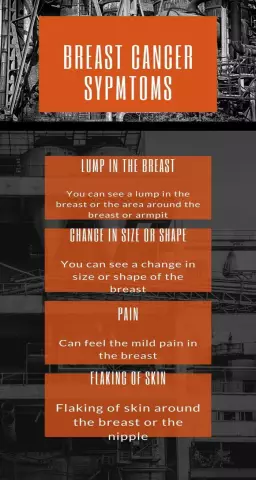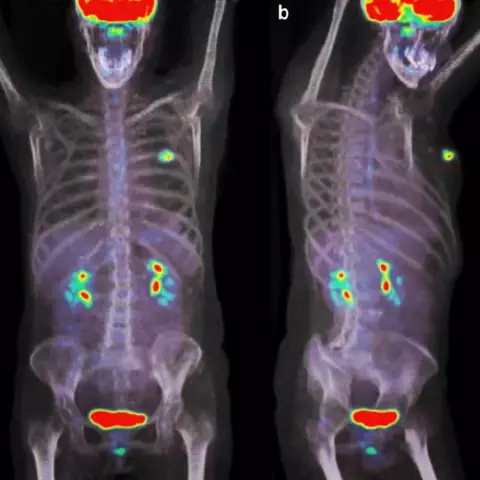- Author Rachel Wainwright [email protected].
- Public 2023-12-15 07:39.
- Last modified 2025-11-02 20:14.
Mammary cancer

Breast cancer is the most common cancer in women.
The incidence of breast cancer is about 10% of the total female population.
The most susceptible to the formation of a tumor are women over 40 years old, in extremely rare cases men get sick with breast cancer.
Causes and risk factors for breast cancer
Because of its widespread occurrence, breast cancer has been studied much more than other cancers. Although the immediate cause of breast cancer is unknown, the factors that contribute to the disease have been clearly identified. These factors include:
- The onset of menstruation before the age of twelve;
- Lack of pregnancy and childbirth;
- The onset of the first pregnancy over the age of thirty;
- History of terminated pregnancies;
- Early interruption of lactation after childbirth, or lack thereof;
- Onset of menopause after fifty years;
- The presence of close relatives with cancer;
- Previous cancer disease;
- Endocrine disorders in the body;
- Disease - fibrocystic breast disease;
- Long-term use of hormonal contraceptives, as well as hormone replacement therapy during menopause;
- Previous trauma to the breast;
- Food with a high content of carcinogenic substances (fatty, fried, smoked food, fast food);
- Age over 40.
Each of these factors does not lead to breast cancer, but increases the risk of disease, especially when several of the above factors are combined.
Breast cancer signs
The problem with breast cancer, like many other cancers, is that the symptoms of the disease often become evident only at the stage of the developed tumor. Early stages of breast cancer are often asymptomatic. The earliest signs of breast cancer are:
1) The appearance of a single or several cartilage-like seals, from a few millimeters to several centimeters in diameter;
2) Changes in the area of the skin of one of the mammary glands, the skin can acquire the characteristic appearance of an orange peel, or be drawn in;
3) In some cases, discharge from the nipple, not associated with lactation, appears, usually of a rusty-bloody or reddish color;
4) The nipple is flattened and retracted, the affected mammary gland may enlarge, or vice versa, decrease in size.
For the usual form with symptoms of breast cancer, soreness is not characteristic, pain syndrome develops only in the terminal stage of the disease. With a mastitis-like form, the symptoms of breast cancer are similar to mastitis: the mammary gland turns red, swells, and becomes painful.
The pain is also expressed in the erysipelas-like form of the disease, in which areas of redness, sharply limited from normal skin, appear, the gland swells, the body temperature rises and the general condition worsens.
Mastitis-like and erysipelas forms of breast cancer are much less common than typical cancer, their danger is that the signs of breast cancer in this case are characteristic not of a tumor, but of an acute inflammatory process, which can be misleading.
Another form of the disease is armored breast cancer. It is characterized by the formation of a dense infiltrate, as a result of which the mammary gland becomes lumpy and hard, like a shell, which in some cases covers the entire chest.
There is also breast nipple cancer, or Paget's cancer, the rarest form of tumor. Symptoms of breast cancer in this case are limited to the lesion of the nipple, the signs are similar to eczema or psoriasis, scales characteristic of psoriasis, or crusts on the background of redness, characteristic of weeping eczema, may appear. When breast cancer symptoms do not go beyond the areola of the nipple, the tumor can spread to both breasts.
Breast cancer metastasizes to the axillary lymph nodes, a sign of the appearance of metastases is the thickening and enlargement of the lymph nodes in size. Through the bloodstream, the tumor can metastasize to the brain, lungs and liver.
Breast Cancer Diagnosis
The main method for diagnosing breast cancer is mammography - an X-ray examination of the mammary glands in different projections. Ultrasound is used as an additional method. The final diagnosis of breast cancer is made on the basis of a biopsy - a laboratory study of a small piece of the tumor taken with a puncture or scraping (for superficial forms of the disease).
To detect possible metastases, MRI (magnetic resonance imaging) is performed, or examination of the lungs, liver and brain using medical imaging methods. Scintigraphy is performed to detect bone metastases.
Breast cancer treatment
Treatment of breast cancer is complex, for which surgical removal of the tumor, therapy with cytostatics and irradiation of regional lymph nodes are performed. A prerequisite, with the exception of the terminal stages, is the operation to remove breast cancer.
There is a classic treatment for breast cancer that is considered the standard for this disease - radical mastectomy. With this method, the mammary gland and all axillary lymph nodes on the affected side are completely removed.

Currently, in connection with improved diagnostic methods, more and more often, in the early stages of the disease, they resort to sparing, organ-preserving breast cancer surgery. Before this, a thorough examination of the sentinel lymph node is carried out - the first to which lymph flows from the tumor. If there are no metastases in the sentinel lymph node, then with a probability of 98% there are none at all. In the treatment of breast cancer, in this case, the tumor itself is removed, plus a few centimeters of the surrounding healthy tissue, supplementing the surgical method with chemotherapy and radiation, as in radical mastectomy.
In the terminal stages, breast cancer surgery is ineffective and can only be used to alleviate suffering. The main methods of treatment for breast cancer in this case are chemotherapy and radiation, we are not talking about a cure, but about prolonging life.
Breast cancer prognosis
The five-year survival rate in the case when the tumor is detected at an early stage, before the onset of clinical symptoms of breast cancer, is over 98%. At the stage of a detailed clinical picture, with the use of complex treatment, including radical mastectomy, irradiation of the lymph nodes and chemotherapy, the five-year survival rate is about 60%. In the presence of distant metastases, the prognosis of breast cancer is poor.
YouTube video related to the article:
The information is generalized and provided for informational purposes only. At the first sign of illness, see your doctor. Self-medication is hazardous to health!






